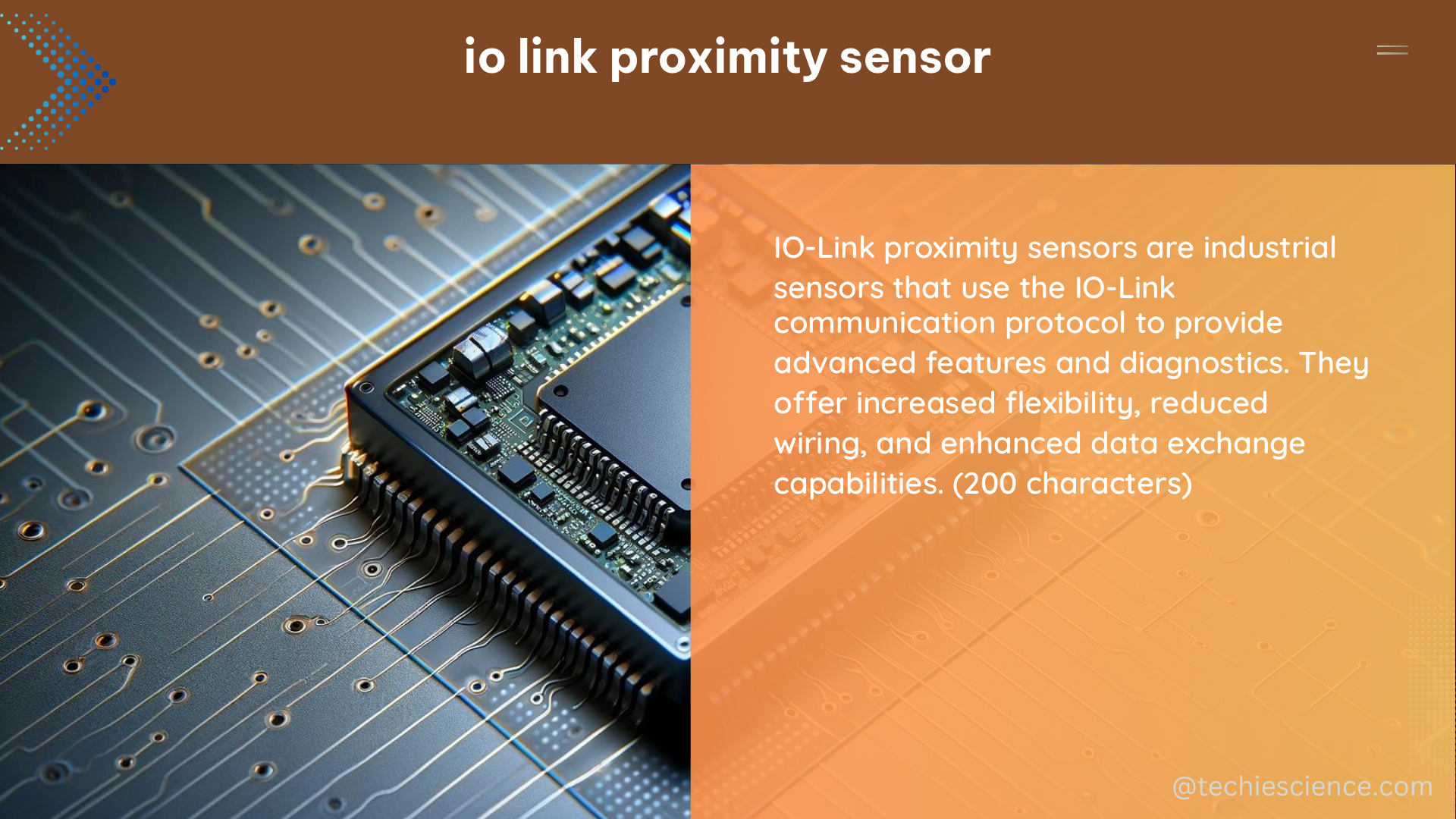The IO-Link proximity sensor is a versatile and powerful tool for industrial automation and process monitoring. This sensor utilizes the IO-Link communication protocol to transmit a wide range of data, enabling manufacturers to collect valuable equipment and environmental information for nearly any data point, regardless of the native availability from the equipment OEM.
Understanding IO-Link Proximity Sensors
IO-Link proximity sensors provide three distinct data types:
- Process Data: This represents the latest state of the device, containing both input and output data, which is cyclically exchanged between the IO-Link master and the IO-Link slave device.
- Parameter Data: This includes information and parameters set within the device, such as the sensor’s measuring range or output type.
- Diagnostics or Event Data: This provides real-time updates on device conditions, including warnings or errors for abnormal situations.
These data types enable a wide range of applications, from coolant flow rate monitoring to temperature, vibration, and signal quality monitoring.
Technical Specifications
- Sensing Range: Typical sensing ranges for IO-Link proximity sensors can vary from a few millimeters up to 60 meters, depending on the specific model and application.
- Sensing Accuracy: IO-Link proximity sensors can achieve accuracies ranging from ±0.1 mm to ±2 mm, depending on the sensing technology and model.
- Response Time: The response time for IO-Link proximity sensors can range from 0.5 ms to 20 ms, allowing for fast detection and reaction times.
- Operating Temperature: IO-Link proximity sensors are designed to operate in a wide temperature range, typically from -25°C to 70°C, with some models rated for extended temperature ranges.
- Protection Rating: IO-Link proximity sensors are available with various protection ratings, such as IP67 and IP69K, ensuring reliable operation in harsh industrial environments.
Key Features and Benefits
- Comprehensive Data Collection: IO-Link proximity sensors can provide a wealth of data, including process values, parameter settings, and real-time diagnostics, enabling advanced condition monitoring and predictive maintenance.
- Flexible Integration: IO-Link proximity sensors can be easily integrated into various industrial communication protocols, such as Profibus, Modbus, and ProfiNet, simplifying system integration.
- Reduced Wiring: IO-Link proximity sensors use a 3-wire connection (power, ground, and data), reducing the complexity and cost of wiring compared to traditional sensor setups.
- Plug-and-Play Connectivity: IO-Link proximity sensors can be easily connected and configured using the IO-Link Competency Matrix, which provides a comprehensive list of technologies, products, and services from IO-Link member companies.
- Improved Productivity: The ability to change sensor settings “on-the-fly” without stopping production lines or machines can lead to increased productivity and optimized processes.
Setting Up an IO-Link Proximity Sensor

To set up an IO-Link proximity sensor, you will need the following components:
- IO-Link Master Device: This device can process both analog and digital signals, serving as the interface between the IO-Link proximity sensor and the control system.
- ifm Master: This device is used to connect the IO-Link proximity sensors to the machine connectivity platform, such as MachineMetrics.
Step-by-Step Setup Guide
- Connect the Sensor: Connect the IO-Link proximity sensor to the IO-Link master device using the 3-wire connection (power, ground, and data).
- Configure the Sensor: Use the IO-Link Competency Matrix to configure the sensor’s parameters, such as the measuring range, output type, and diagnostic settings.
- Integrate with MachineMetrics: Utilize the ifm master to connect the IO-Link proximity sensor to the MachineMetrics platform, enabling autonomous data standardization across machines and devices.
- Set Up Monitoring Workflows: Depending on the application, configure the sensor to monitor specific parameters, such as coolant flow rate, temperature, vibration, or signal quality. Set appropriate thresholds and alarms to trigger notifications when abnormal conditions are detected.
- Optimize Processes: Leverage the ability to change sensor settings “on-the-fly” to fine-tune the system and improve productivity and efficiency.
Unique Capabilities of IO-Link Proximity Sensors
IO-Link proximity sensors offer several unique capabilities that set them apart from traditional sensor technologies:
- Real-Time Diagnostics: The ability to provide real-time updates on device conditions, including warnings or errors for abnormal situations, is particularly valuable for predictive maintenance. This allows manufacturers to identify and address potential issues before they become major problems.
- Communication Protocol Compatibility: IO-Link proximity sensors can be easily integrated into various industrial communication protocols, such as Profibus, Modbus, and ProfiNet, simplifying system integration and reducing the time and resources required for installation and maintenance.
- Expanded Data Visibility: Compared to standard I/O devices, IO-Link proximity sensors offer broader capabilities, providing visibility into a much wider range of data and the ability to change sensor settings “on-the-fly” without interrupting production.
By leveraging these unique capabilities, manufacturers can improve productivity, optimize processes, and enhance their overall equipment effectiveness (OEE) through advanced condition monitoring and predictive maintenance strategies.
Conclusion
IO-Link proximity sensors are a powerful tool for industrial automation and process monitoring, offering a wealth of data and advanced capabilities that can significantly improve operational efficiency and maintenance efforts. By understanding the technical specifications, key features, and unique capabilities of these sensors, manufacturers can unlock new opportunities for optimization and gain a competitive edge in their respective industries.
References:
- What Is IO-Link 1-1 and How Is It Used – DigiKey. (2020-04-20). Retrieved from https://www.digikey.com/en/articles/what-is-io-link-1-1-and-how-is-it-used
- What is IO-Link? Collecting Data from Sensors and Actuators. (n.d.). Retrieved from https://www.machinemetrics.com/connectivity/protocols/io-link
- What data can IO-Link provide? | Balluff. (n.d.). Retrieved from https://www.balluff.com/en-us/blog/what-data-can-io-link-provide
- IO-Link event data: Sensors tell you how they’re working – Balluff. (n.d.). Retrieved from https://www.balluff.com/en-us/blog/io-link-event-data-how-sensors-tell-you-how-they-re-working

The lambdageeks.com Core SME Team is a group of experienced subject matter experts from diverse scientific and technical fields including Physics, Chemistry, Technology,Electronics & Electrical Engineering, Automotive, Mechanical Engineering. Our team collaborates to create high-quality, well-researched articles on a wide range of science and technology topics for the lambdageeks.com website.
All Our Senior SME are having more than 7 Years of experience in the respective fields . They are either Working Industry Professionals or assocaited With different Universities. Refer Our Authors Page to get to know About our Core SMEs.